9. How did you handle: EDUCATION and FULFILLMENT?
Schooling
Homeschooling your cruising kid can have great benefits.
- For a gifted student, like Kate, it provided the chance to dive deep into subjects that interested her. A challenging curriculum tailored to her own interests prevented boredom.
- For the average student, homeschooling may provide the motivation to excel, to rise to their true abilities.
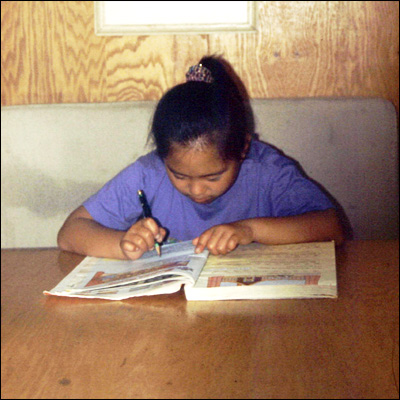 |
Kenna does school work
aboard OUT OF BOUNDS |
- For the student who has been one step behind in the classroom, it will provide the opportunity to develop and learn at his own pace.
Kenna, who is mildly mentally retarded, had great success at homeschool because it was easy to tailor a curriculum that fit her needs. Learning was always a positive experience for her. Her success at school in turn helped built great self-esteem and self-confidence.
We also found the cruising community to be very warm and welcoming towards Kenna. They accepted her for who she was. Kenna never had to endure the pain of name calling or being ostracized.
Kenna also needed help with her speech. We found that with the initial help of professionals, speech is something a parent can continue to work on with a child while cruising. I'm sure this is true of many other special needs, as well.
I hope that parents of other special needs kids will not automatically assume that cruising isn't a possibility for them.
Homeschooling was an awesome experience.
When we started homeschooling in 1991 there were few resources for homeschoolers. And all of the cruising magazines seemed to recommend using Calvert Correspondence School.
 |
Navigation was an important part of math class. |
We discovered that there were other methods to homeschooling our children and what we did could best be called eclectic.
Here's my favorite quote, which is by Maura Segar, “When we started homeschooling, I felt as though I had tucked a child under each arm and jumped off a cliff. Imagine my surprise to discover we have wings.” Most homeschooling families find success by trying different methods, by combining what works from one method with that of another and by remembering that your homeschool is not static, but always changing and growing with your own needs.
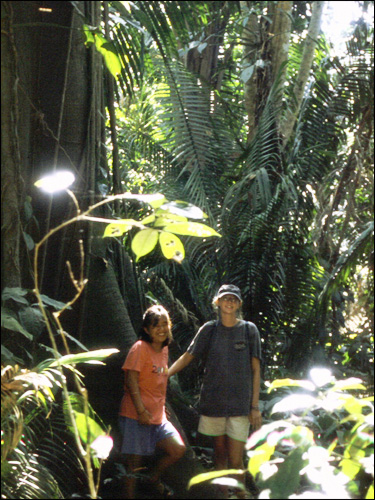 |
We studied Mayan history and rainforests while cruising the Rio Dulce of Guatemala |
- What works for one cruising family may not be what is best for your family.
- What worked at the beginning of the school year may be “burning out” both parents and kids six months later.
- And what worked great for your kids when they were younger may need to be changed when they reach the middle school years.
The key to a successful transition into homeschooling is to take it slowly and be patient with yourself and your family.
Be flexible. Throw out what doesn't work. Try new ideas. Let your own homeschooling system develop for your own family. You'll probably discover it becomes a rich assortment of ideas.
We tailored our curriculum to take advantage of the places where we would be sailing to as well as our kids' special interests.
We often created unit studies, which would incorporate various disciplines such as reading, writing, science, history, geography, art, music, etc to study a subject. And it was easy and fun to teach both girls the same subject, just on different levels. We studied Mayan history and rainforests while cruising the Rio Dulce of Guatemala and coral reefs while in Belize.
While cruising in North Carolina one fall we choose FLIGHT for a unit study.
- We read books such as Chitty, Chitty, Bang, Bang, The Fledgling and Around the World in Eighty Days (we read out loud every day – a good idea even after the kids are old enough to read to themselves).
- Writing assignments included both fictional stories with a “flight” theme as well as factual reports and even a “business” letter to the Federal Aviation Administration who sent us a package of information. Science was filled with hands-on experiments, which demonstrated the principles involved in flight. Some of our experiments included flying kites, paper airplanes, and balsa planes.
- We took a field trip to the Wright Brothers Memorial at Kitty Hawk, NC where Orville's and Wilbur's famous flight was brought to life for us.
- We followed that study with “Space Exploration” as we sailed down the East Coast to Florida. Again our studies included both fictional and non-fictional reading, experiments and writing assignments. Tom and the girls built and launched an Estes rocket kit. Computer software allowed us to fly to Mars or dock with a space station.
- The finale to our studies was watching a shuttle launch from Cape Canaveral and visiting the Kennedy Space Center museums.
|
We homeschooled right through high school. Kate was instrumental in choosing her high school curriculum. She was accepted (and offered a full ride) to CalTech, one of the most difficult schools to gain admission to. She ultimately chose to go to New Mexico Tech to study astrophysics.
Kate's monthly newsletter: the "Out of Bounds Outburst"
My philosophy was for Kate to simply enjoy writing. To do this, we separated writing from grammar. When asking your kids to write something creative, the important thing is to let them write. Let them get their ideas out. Don't make them worry about sentence structure or grammar or punctuation. If your child balks at the idea of writing, it may be because every time they write their heart out, they get back a paper full of red marks at every mistake they've made.
Kate kept a journal. Sometimes she would write in it furiously for months and then nothing for week and weeks. I might remind her that she could write in her journal, but I never forced her to and I never read what she wrote. She also wrote loads of postcards and letter to friends and relatives.
When she was in first and second grade, she came up with the idea to “write down” the news - our family news - everyday and then on Friday, she would give us an oral report. She did this as if she were a television newscaster. In third grade this project turned into writing a newsletter that she called the Out of Bounds Outburst.
The Outburst was a monthly newsletter that she sent to relatives. She did the Outburst on the computer, so she was learning computer skills as well (this was in 1994, so the software seems primitive to what we have today!).
She'd write about places we'd been, things we'd done, where we were heading to next, she might write a poem. Sometimes I would give her assignments to get her to write in different ways. She might do a first-person essay on her field trip to the maritime museum and a third-person report on the straw market in Nassau. She might write a more technical account of rainforests and a book report on the latest book that she read.
When the newsletter was completed she would mail one copy to her grandmother in the States (we didn't have email), who would copy, address and mail them to the other 20 or so friends and relatives who “subscribed.”
Kate wrote and published the Outburst for probably 5 years or so. |
Friendships and social interactions
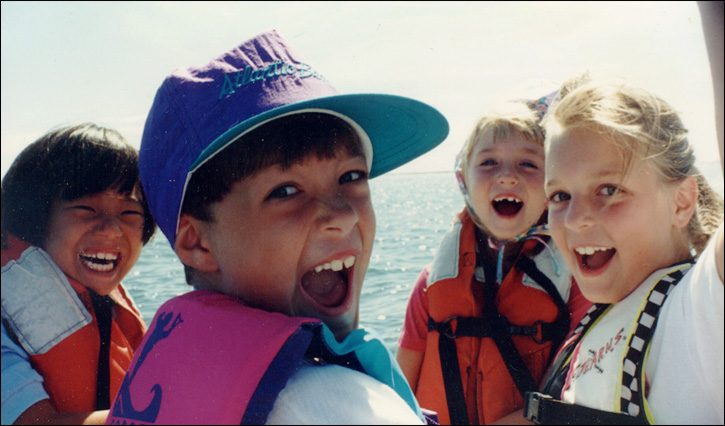 |
Kenna (back left) and Kate (back right) enjoy an onboard birthday party
with their visiting cousins, Sammy Jo (left) and Amy (right).
This was Kate's 8th birthday in 1994. |
A common concern facing new cruising families is socialization.
Actually, most families who cruise find that improved social skills are a benefit of cruising. Cruising kids have a unique opportunity to interact with adults and children of all ages and backgrounds. If you (or your kids) are worried about the lack of socialization or lack of friends, rest assured; there is a cruising community of kids out there. I'd recommend heading to a place where cruising kids tend to gather when you first start cruising, for example, George Town, Bahamas.
Cruising kids gathered in one stop will often set up a “kids net” on the VHF. They will invite any new kids to join in as they make plans for their day's activities. Parents are thrilled as they see the kids "hit the books" in the morning so they can be done in time for the afternoon fun. Often times, two or more cruising families who meet and enjoy each other's company will temporarily change plans so they can spend more time cruising together or “Buddy Boating.”
Kids learn quickly that they can make new friends easily as they cruise.
One year we anchored and sailed for nearly 4 months with 7 children from 3 boats.
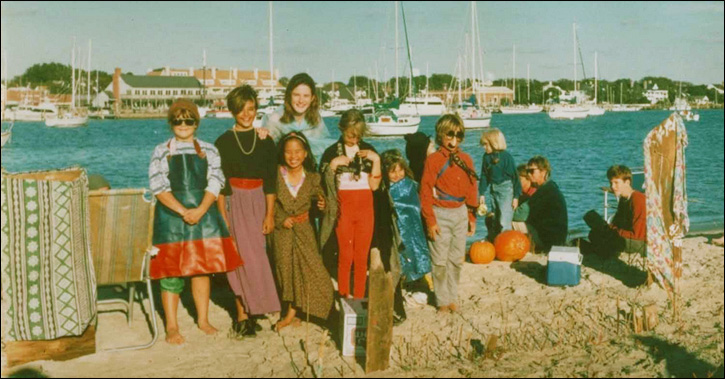 |
Cruising boats from around the world gathered together,
including the kids from s/v OUT OF BOUNDS, s/v KITARRA and s/v NIMANOA and put on a play. |
We looked forward to the chance to get together with other cruising families. One year we anchored and sailed for nearly four months with 7 children from three boats with another dozen or more kids from all parts of the world joining our group for several days or weeks at a time.
The kids put on a play - doing everything from acting to making costumes and making a stage on a nearby island. I wasn't invited to the dress rehearsal but as I peeked out the port I saw the young actors performing in front of half a dozen wild horses who happened to be grazing in front of the stage. The play was a big success, watched by 15 or so parents and friends and three dogs.
The kids found a local potter who invited them to try their hand at making pottery over a course of several afternoon sessions. A retired teacher (also living aboard) set up a creative writing class every Tuesday afternoon on one of the boats. As a group we took field trips to area museums. One of the mothers, a talented artist, took the kids for afternoons of sketching on the beach. Another parent, a world-renowned classical guitarist, was delighted with one of our daughters' interest in the guitar and took her under his wing with music lessons. |
Our girls have enjoyed holiday celebrations and birthday parties whose memories will last a lifetime. And of course there were plenty of dinghy races, soccer matches, and impromptu games that usually included pirates, treasures and mutinous crews of sailors.
You may need to seek out other cruising families, but once you find them you will discover plenty of opportunities for socializing. When other kids are few and far between, allowing your kids to keep in touch with their friends on the SSB is a great idea. Don't dismiss the importance of the social benefits to be gained by spending time together as a family. In our society we seem to forget that the family unit should be the most important part of our kids' lives. Their social skills should start at home.
During Kate's first semester at college, she remarked how few of the students initiated or really engaged in conversations with their professors.
It was a natural thing for her to do. “Why wouldn't you want to engage these amazing people in a discussion about a topic that interests both of you,” was her comment. |
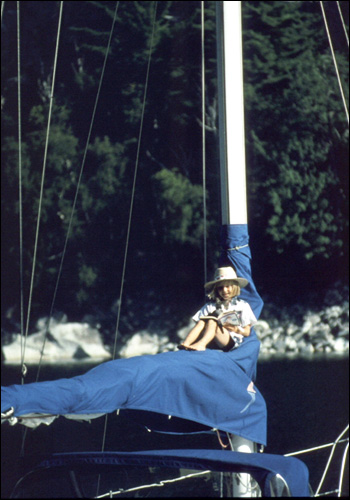 |
Reading on the boom was
one of Kate's favorite pastimes |
Keeping the kids entertained
I've never felt that we need to keep the kids entertained.
Cruising and its associated activities offer wonderful opportunities for entertainment. Snorkeling is one of our favorite activities. Tom and Kate also enjoy scuba diving.
We love to explore the places we visit: meeting new friends, hiking, visiting museums or historical sites, taking in local celebrations and festivals, trying new food, etc.
We read an amazing amount of books. Personal space aboard
Cruising families will need to learn to provide for privacy, as it doesn't come easy.
But you will also learn to love the closeness.
Respect your child's occasional desire to be left alone. This may mean simply that you give them some space down below while you enjoy your own private time in the cockpit. If your children are old enough, you might take a dinghy ride or a walk on the beach while they stay aboard. When stuck on the boat, a personal CD player with headphones or an mp3 player can give you a feeling of privacy. Likewise parents need occasionally alone time - with or without their mate. Try swapping “babysitting” time with other cruising families. We like to invite all the cruising kids in an anchorage over for “movie and popcorn” night once in awhile. Likewise, our kids were invited to other boats for an occasional sleepover or an afternoon outing with friends.
We set aside time every day for silent reading. Even when our kids were small, they would spend a half hour looking at or reading picture books. This has now grown to an hour of reading time. This quiet time gives us all a chance to be “in our own world” even if we're all together.
When it comes to making living aboard a boat comfortable, the important thing to remember is not the size of your boat but the amount of consideration and respect you show to other family members. Laughs and hugs go a long way toward making your floating home a happy home. So the next time your whole family inadvertently converges in one spot, try not to step on too many toes. Instead have a big family hug. |